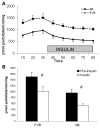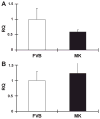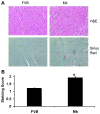Cardiac phosphatase-deficient 6-phosphofructo-2-kinase/fructose-2,6-bisphosphatase increases glycolysis, hypertrophy, and myocyte resistance to hypoxia
- PMID: 18456722
- PMCID: PMC4239994
- DOI: 10.1152/ajpheart.91501.2007
Cardiac phosphatase-deficient 6-phosphofructo-2-kinase/fructose-2,6-bisphosphatase increases glycolysis, hypertrophy, and myocyte resistance to hypoxia
Abstract
During ischemia and heart failure, there is an increase in cardiac glycolysis. To understand if this is beneficial or detrimental to the heart, we chronically elevated glycolysis by cardiac-specific overexpression of phosphatase-deficient 6-phosphofructo-2-kinase/fructose-2,6-bisphosphatase (PFK-2) in transgenic mice. PFK-2 controls the level of fructose-2,6-bisphosphate (Fru-2,6-P2), an important regulator of phosphofructokinase and glycolysis. Transgenic mice had over a threefold elevation in levels of Fru-2,6-P2. Cardiac metabolites upstream of phosphofructokinase were significantly reduced, as would be expected by the activation of phosphofructokinase. In perfused hearts, the transgene caused a significant increase in glycolysis that was less sensitive to inhibition by palmitate. Conversely, oxidation of palmitate was reduced by close to 50%. The elevation in glycolysis made isolated cardiomyocytes highly resistant to contractile inhibition by hypoxia, but in vivo the transgene had no effect on ischemia-reperfusion injury. Transgenic hearts exhibited pathology: the heart weight-to-body weight ratio was increased 17%, cardiomyocyte length was greater, and cardiac fibrosis was increased. However, the transgene did not change insulin sensitivity. These results show that the elevation in glycolysis provides acute benefits against hypoxia, but the chronic increase in glycolysis or reduction in fatty acid oxidation interferes with normal cardiac metabolism, which may be detrimental to the heart.
Figures








Similar articles
-
Cardiac expression of kinase-deficient 6-phosphofructo-2-kinase/fructose-2,6-bisphosphatase inhibits glycolysis, promotes hypertrophy, impairs myocyte function, and reduces insulin sensitivity.J Biol Chem. 2004 Nov 12;279(46):48085-90. doi: 10.1074/jbc.M405510200. Epub 2004 Aug 25. J Biol Chem. 2004. PMID: 15331593
-
Exercise-Induced Changes in Glucose Metabolism Promote Physiological Cardiac Growth.Circulation. 2017 Nov 28;136(22):2144-2157. doi: 10.1161/CIRCULATIONAHA.117.028274. Epub 2017 Aug 31. Circulation. 2017. PMID: 28860122 Free PMC article.
-
Reduced cardiac fructose 2,6 bisphosphate increases hypertrophy and decreases glycolysis following aortic constriction.PLoS One. 2013;8(1):e53951. doi: 10.1371/journal.pone.0053951. Epub 2013 Jan 7. PLoS One. 2013. PMID: 23308291 Free PMC article.
-
6-phosphofructo-2-kinase/fructose-2,6-bisphosphatase: head-to-head with a bifunctional enzyme that controls glycolysis.Biochem J. 2004 Aug 1;381(Pt 3):561-79. doi: 10.1042/BJ20040752. Biochem J. 2004. PMID: 15170386 Free PMC article. Review.
-
Insulin and ischemia stimulate glycolysis by acting on the same targets through different and opposing signaling pathways.J Mol Cell Cardiol. 2002 Sep;34(9):1091-7. doi: 10.1006/jmcc.2002.2063. J Mol Cell Cardiol. 2002. PMID: 12392881 Review.
Cited by
-
Metabolomic profiling of the heart during acute ischemic preconditioning reveals a role for SIRT1 in rapid cardioprotective metabolic adaptation.J Mol Cell Cardiol. 2015 Nov;88:64-72. doi: 10.1016/j.yjmcc.2015.09.008. Epub 2015 Sep 24. J Mol Cell Cardiol. 2015. PMID: 26388263 Free PMC article.
-
Reprogramming of Mitochondrial and Cellular Energy Metabolism in Fibroblasts and Cardiomyocytes: Mechanisms and Therapeutic Strategies in Cardiac Fibrosis.J Cardiovasc Transl Res. 2025 Aug 18. doi: 10.1007/s12265-025-10678-z. Online ahead of print. J Cardiovasc Transl Res. 2025. PMID: 40825914 Review.
-
Type 2 Diabetes Dysregulates Glucose Metabolism in Cardiac Progenitor Cells.J Biol Chem. 2016 Jun 24;291(26):13634-48. doi: 10.1074/jbc.M116.722496. Epub 2016 May 5. J Biol Chem. 2016. PMID: 27151219 Free PMC article.
-
Cardiomyocyte Ogt limits ventricular dysfunction in mice following pressure overload without affecting hypertrophy.Basic Res Cardiol. 2017 May;112(3):23. doi: 10.1007/s00395-017-0612-7. Epub 2017 Mar 15. Basic Res Cardiol. 2017. PMID: 28299467 Free PMC article.
-
The Role of Metabolism in Heart Failure and Regeneration.Front Cardiovasc Med. 2021 Jul 16;8:702920. doi: 10.3389/fcvm.2021.702920. eCollection 2021. Front Cardiovasc Med. 2021. PMID: 34336958 Free PMC article. Review.
References
-
- Augustus AS, Buchanan J, Park TS, Hirata K, Noh HL, Sun J, Homma S, D’Armiento J, Abel ED, Goldberg IJ. Loss of lipoprotein lipase-derived fatty acids leads to increased cardiac glucose metabolism and heart dysfunction. J Biol Chem. 2006;281:8716–8723. - PubMed
-
- Beauloye C, Marsin AS, Bertrand L, Vanoverschelde JL, Rider MH, Hue L. The stimulation of heart glycolysis by increased workload does not require AMP-activated protein kinase but a wortmannin-sensitive mechanism. FEBS Lett. 2002;531:324–328. - PubMed
-
- Belke DD, Larsen TS, Gibbs EM, Severson DL. Altered metabolism causes cardiac dysfunction in perfused hearts from diabetic (db/db) mice. Am J Physiol Endocrinol Metab. 2000;279:E1104–E1113. - PubMed
-
- Belke DD, Larsen TS, Gibbs EM, Severson DL. Glucose metabolism in perfused mouse hearts overexpressing human GLUT-4 glucose transporter. Am J Physiol Endocrinol Metab. 2001;280:E420–E427. - PubMed
Publication types
MeSH terms
Substances
Grants and funding
LinkOut - more resources
Full Text Sources
Molecular Biology Databases

